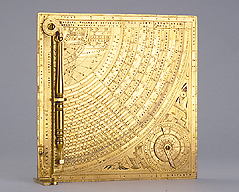
 |
| Catalogue |
 |
 Quadrant The right hand side bears a 'CALENDARIVM ET LOCVS SOLIS', marked with the Latin names of the zodiacal signs and their symbols, and the Latin names of the months, grouped according to the seasons, marked in Latin as 'VER, AESTAS, AVTHVMNVS, HYEMS'. Each sign has a 30? scale, numbered by 10 and divided to 2 by alternate shading. The months have scales with the corresponding number of days, numbered by 10 and divided to 2 days. Further to the outside of the Scala Iacendi and the Calendarium is a degree scale 0 to 90, numbered by 10 and divided to 1. Further towards the edge of the square, outside the quadrantal scale, is a volvelle for the indication of the planetary rulers of each of the 24 hours of every day of the week. This consists of three fixed scales and a rotatable disc. The three scales are marked (from the outside) with the Latin names of the days in the order of their apparent distance from the earth (Moon, Mercury, Venus, Sun, Mars, Jupiter, Saturn), their number (starting with Sunday as 1) and the corresponding planetary symbols. The movable disc is marked with a spiral scale twice 1 to 12. An index fixed to this disc is marked with a 'D'. Over this disc moves another index, also marked 'D'. In the top left-hand corner are two horary quadrants for equal and unequal hours in the style of Gunter quadrants. The innermost is labelled 'HORAE COMMVN' with the hour lines marked 5 to 12 to 7. A scale at the right hand edge of this quadrant is marked with the symbols of the zodiacal signs, each sign has a 30? scale, numbered by 10 and divided to 5. The symbol for Scorpio resembles the animal. A scale further to the outside is labelled 'horae post' / 'ante meridie<m>', the hour lines are marked 6 to 12 to 6. The outermost quadrant has hour lines 1 to 6 to 12, and another zodiacal scale, but here Scorpio is indicated with the usual symbol. Further to the outside is a scale labelled 'Horae planetarum' with hour lines 1 to 6 to 12. Closest to the tip is a shadow square, marked 'um{bra} ve{rsa}' and 'um{bra} re{cta}', to the base 12, numbered by 6 and divided to 2. A pivoted index carrying a plumb bob has a double zodiacal scale with the symbols and a 'SCALA IACENDI' 1 to 24 numbered by 1. The markings correspond to the markings of the two horary quadrants and the Scala Iacendi. The edges of the square plate are marked with further scales as follows (starting at the left hand side, anticlockwise): a linear scale marked 'ZOL MONACHIVM' 0 to 6, numbered by 1. The units are further divided: 2 to 1/2, 3 to 1/3, 4 to 1/4, 5 to 1/5, and 6 to 1/6. The sixth unit is covered by the foot of the instrument. A non linear scale marked 'PLVMBVM', 1/4 to 30, numbered 1/4, 2/4, 3/4, 1, 2, 3, 4, 5, 10, 15, 20, 25, and divided to 1. The number 30 is covered by the foot of the instrument. A non-linear scale marked 'FERRVM', numbered 1/4, 2/4, 3/4, 1, 2, 3, 4, 5, 10, 15, 20, and divided to 1. A non linear scale 'LAPIS' 1/4, 2/4, 3/4, 1, 2, 3, 4, 5 (6, 7?). The four corners of the square are marked 'A', 'B', 'C', 'D'. The signature of the maker and the date 'THOBIAS VOLCKMER BRVNSWEIGSENSIS FACIEBAT ANNO 1609' are inscribed along the edge which also has the 'LAPIS' scale. The reverse bears markings for a sinical quadrant, the arc with a degree scale 0 to 90 to 0, numbered by 10 and divided to 5 and subdivided to 1 by alternate shading. The two edges of the quadrant both bear scales 0 to 45, numbered by 5. The quadrant itself is laid out in a chequer board design, with one small square for each unit. A double index consisting of two independent arms is pivoted at the tip of the quadrant. Both arms have a scale 0 to 45, numbered by 5 and divided to 1 by alternate shading. One arm carries a pair of sights. Outside the quadrant there is a compass rose with the four cardinal points marked in Latin and the eight main directions marked in German. Around the compass rose there is a circular scale 0 to 24, numbered by 1 and divided to 1/2. On each side of the square is a linear scale 0 to 6, numbered by 1 and divided to 1/2. The four corners of the square are marked 'E', 'F', 'G', 'H'. An engraved foot screwed to the instrument allows it to stand vertically. The instrument is decorated with strapwork, flowers and fruit. The engravings are filled with black and red colouring. The instrument was formerly in the Spitzer collection and is described in F. A. B. Ward, A Catalogue of European Scientific Instruments in the Department of Medieval and Later Antiquities of the British Museum (London, 1981), p. 93 ff., no. 272. See also M. Miniati, "Le cadran universel de Tobias Volckmer conserv? au Mus?e d'Histoire des Sciences de Florence", ANCAHA 46 (1986), pp. 55-62. Silke Ackermann |



